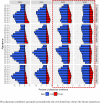Future projection of the physician workforce and its geographical equity in Japan: a cohort-component model
- PMID: 30224401
- PMCID: PMC6144402
- DOI: 10.1136/bmjopen-2018-023696
Future projection of the physician workforce and its geographical equity in Japan: a cohort-component model
Abstract
Introduction: The geographical inequity of physicians is a serious problem in Japan. However, there is little evidence of inequity in the future geographical distribution of physicians, even though the future physician supply at the national level has been estimated. In addition, possible changes in the age and sex distribution of future physicians are unclear. Thus, the purpose of this study is to project the future geographical distribution of physicians and their demographics.
Methods: We used a cohort-component model with the following assumptions: basic population, future mortality rate, future new registration rate, and future in-migration and out-migration rates. We examined changes in the number of physicians from 2005 to 2035 in secondary medical areas (SMAs) in Japan. To clarify the trends by regional characteristics, SMAs were divided into four groups based on urban or rural status and initial physician supply (lower/higher). The number of physicians was calculated separately by sex and age strata.
Results: From 2005 to 2035, the absolute number of physicians aged 25-64 will decline by 6.1% in rural areas with an initially lower physician supply, but it will increase by 37.0% in urban areas with an initially lower supply. The proportion of aged physicians will increase in all areas, especially in rural ones with an initially lower supply, where it will change from 14.4% to 31.3%. The inequity in the geographical distribution of physicians will expand despite an increase in the number of physicians in rural areas.
Conclusions: We found that the geographical disparity of physicians will worsen from 2005 to 2035. Furthermore, physicians aged 25-64 will be more concentrated in urban areas, and physicians will age more rapidly in rural places than urban ones. The regional disparity in the physician supply will worsen in the future if new and drastic measures are not taken.
Keywords: Japan; aged physician; female physician; future projection; geographic distribution.
© Author(s) (or their employer(s)) 2018. Re-use permitted under CC BY-NC. No commercial re-use. See rights and permissions. Published by BMJ.
Conflict of interest statement
Competing interests: None declared.
Figures




Similar articles
-
Examining changes in the equity of physician distribution in Japan: a specialty-specific longitudinal study.BMJ Open. 2018 Jan 8;8(1):e018538. doi: 10.1136/bmjopen-2017-018538. BMJ Open. 2018. PMID: 29317415 Free PMC article.
-
Examining sufficiency and equity in the geographic distribution of physicians in Japan: a longitudinal study.BMJ Open. 2017 Mar 14;7(3):e013922. doi: 10.1136/bmjopen-2016-013922. BMJ Open. 2017. PMID: 28292766 Free PMC article.
-
Does the insufficient supply of physicians worsen their urban-rural distribution? A Hiroshima-Nagasaki comparison.Rural Remote Health. 2012;12:2085. Epub 2012 Apr 26. Rural Remote Health. 2012. PMID: 22533349
-
Surplus or shortage? Unraveling the physician supply conundrum.West J Med. 1991 Jan;154(1):43-50. West J Med. 1991. PMID: 2024510 Free PMC article. Review.
-
Foreign medical graduates and U.S. physician supply: old issues and new questions.Health Policy. 1993 Aug;24(3):213-25. doi: 10.1016/0168-8510(93)90041-m. Health Policy. 1993. PMID: 10128126 Review.
Cited by
-
How is increased selectivity of medical school admissions associated with physicians' career choice? A Japanese experience.Hum Resour Health. 2020 May 27;18(1):38. doi: 10.1186/s12960-020-00480-0. Hum Resour Health. 2020. PMID: 32460757 Free PMC article.
-
The number of physicians is related to the number of nighttime emergency surgeries in Japan: An ecological study.PLoS One. 2022 Dec 1;17(12):e0278517. doi: 10.1371/journal.pone.0278517. eCollection 2022. PLoS One. 2022. PMID: 36454998 Free PMC article.
-
Visualization and Improvement of the Quality, Efficiency, and Equity of the Healthcare System - Secondary Publication.JMA J. 2024 Apr 15;7(2):147-152. doi: 10.31662/jmaj.2023-0196. Epub 2024 Apr 11. JMA J. 2024. PMID: 38721069 Free PMC article. Review.
-
Projections of psychiatrists' distribution for patients in Japan: a utilization-based approach.Hum Resour Health. 2021 Apr 9;19(1):49. doi: 10.1186/s12960-021-00594-z. Hum Resour Health. 2021. PMID: 33836799 Free PMC article.
-
Factors associated with regional differences in healthcare quality for patients with acute myocardial infarction in Japan.PLoS One. 2025 Apr 16;20(4):e0319179. doi: 10.1371/journal.pone.0319179. eCollection 2025. PLoS One. 2025. PMID: 40238801 Free PMC article.
References
Publication types
MeSH terms
LinkOut - more resources
Full Text Sources
Other Literature Sources
Medical
